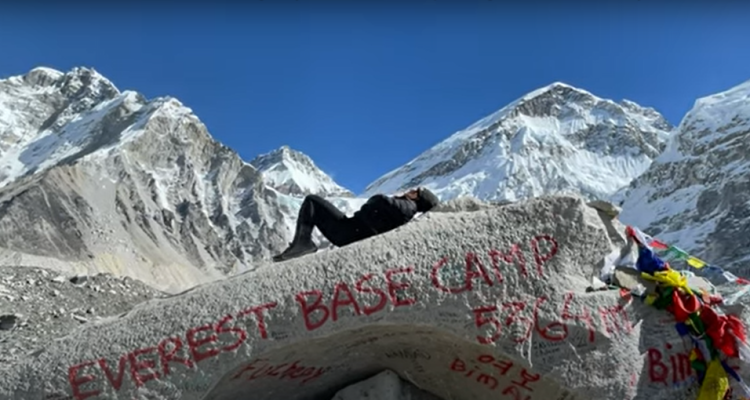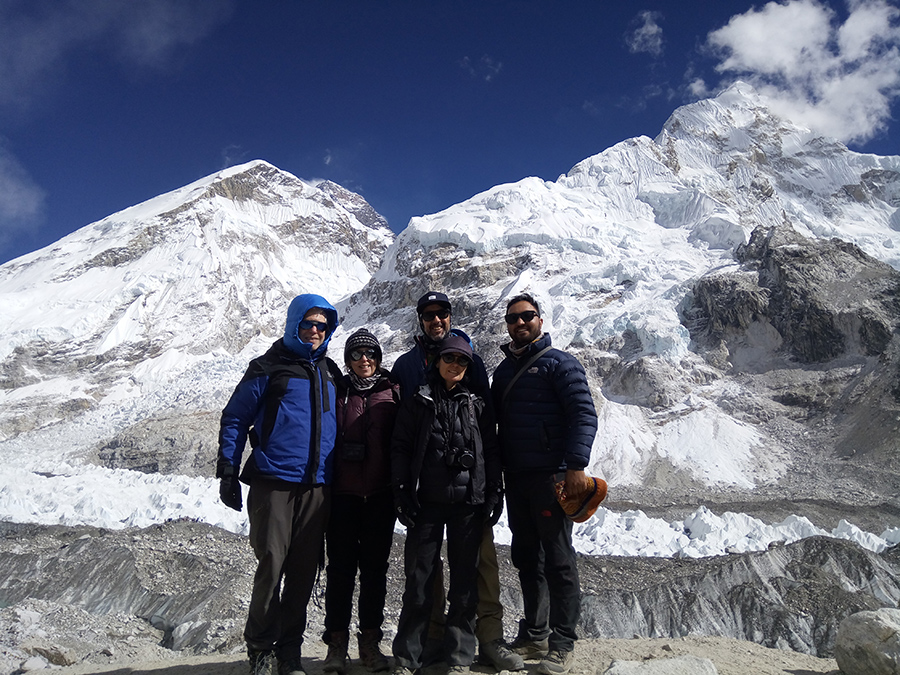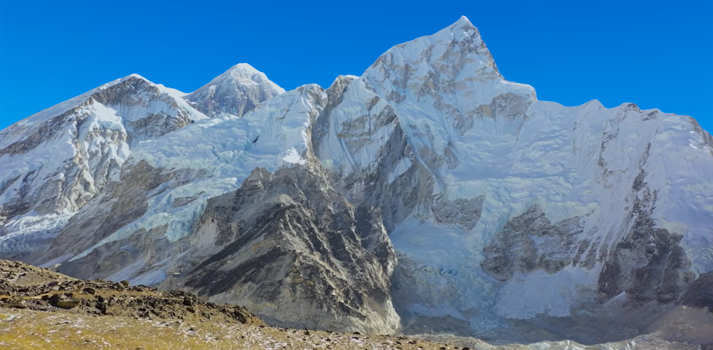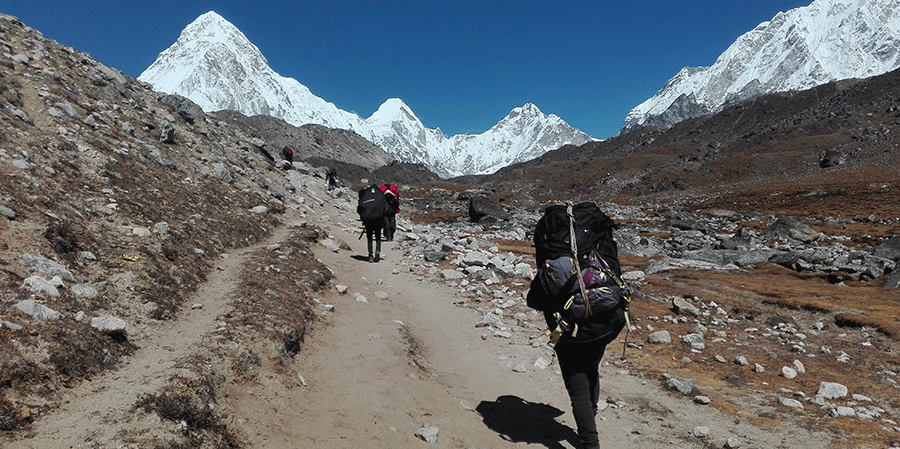August 22, 2023

Imagine standing at the foothills of the mightiest mountain on Earth, Mount Everest. It’s a place where adventurers come to test their limits and connect with nature’s grandeur. This special place is called Everest Base Camp, and it’s where journeys of a lifetime begin. While people visit all year round, there’s something truly enchanting about going there in January or February. These are the coldest months, turning the landscape into a frosty wonderland. In this article, we’ll explore what it’s like to trek to Everest Base Camp during this chilly time of year. We’ll talk about the stunning beauty, the things you need to plan for, and the amazing stories that happen against the backdrop of snow-covered mountains. So, if you’re up for an adventure that’s both freezing and fantastic, let’s discover the magic of trekking to Everest Base Camp in the winter months.
During January and February, trekking in Everest Base Camp can be quite challenging due to the harsh weather conditions. These months fall within the winter season in the Everest region, and the temperatures can be extremely cold, especially at higher altitudes. Here’s what you can generally expect in terms of weather and climate during this period:
Temperature: In January and February, temperatures in the Everest Base Camp area can range from extremely cold to freezing. Daytime temperatures at lower elevations (around Namche Bazaar) might hover around 0°C to -10°C (32°F to 14°F), while at night and at higher altitudes, they can plummet to -20°C to -30°C (-4°F to -22°F) or even lower.
Snowfall: Snowfall is common during these months, and the trails, as well as the higher passes, can be covered in snow. The amount of snowfall can vary from year to year. The trails might be more challenging to navigate due to snow and ice, and some parts of the route could potentially be blocked.
Visibility: Weather conditions can impact visibility, and you might encounter cloudy or foggy days, which could obscure your views of the magnificent landscapes. Clear days are also possible, offering stunning panoramic views of the snow-covered peaks.
Altitude: Trekking in the Everest region involves significant altitude gain. Acclimatization is crucial to prevent altitude sickness. During January and February, many of the teahouses along the trail might be closed due to the extreme cold, so you need to plan your trek accordingly and ensure you have proper accommodation and food options.
Crowds: January and February are considered the offseason for trekking in the Everest region due to the challenging weather conditions. This means that the number of trekkers is significantly lower compared to the peak seasons of spring and fall. You might find fewer people on the trails and in the teahouses.
Gear: Given the cold temperatures and potential snowfall, you’ll need to be well-prepared with appropriate cold-weather gear, including insulated clothing, down jackets, warm gloves, hats, and sturdy trekking boots. It’s crucial to have the right gear to stay warm and safe during the trek.
Daylight: Days are relatively shorter during these months, with fewer hours of daylight. This means you’ll have limited time for trekking each day, and it’s essential to plan your itinerary accordingly.

Trekking to Everest Base Camp Trek in January and February can be a rewarding experience for those who are well-prepared for the cold weather and are up for the challenge. However, it’s important to note that the weather can be quite unpredictable, and conditions can change rapidly in mountainous areas. Therefore, it’s recommended to consult with experienced trekking guides and make sure you have the necessary permits and equipment before embarking on the journey.
Visiting Everest Base Camp in January and February offers a unique and less crowded experience compared to peak trekking seasons. The tranquil beauty of the snow-covered landscape is mesmerizing. Trails are quieter, allowing for a deeper connection with nature. Accommodation and services are more accessible, enhancing comfort. The crisp air and clear skies provide stunning views of the surrounding peaks. While colder temperatures require appropriate gear, the challenge adds to the adventure. Exploring during these months provides a chance to witness local culture and festivals. Overall, the serenity, stunning vistas, and cultural insights make this an unforgettable winter trekking experience.
Preparing for the Everest Base Camp (EBC) trek demands careful planning and suitable equipment. Begin with comprehensive physical training to build endurance and stamina for the challenging terrain. Acclimatization is crucial due to altitude, so schedule rest days during the trek. Clothing should include moisture-wicking layers, insulated jackets, and sturdy, comfortable footwear. Don’t forget essential accessories like sunglasses, hats, and gloves. A well-fitted backpack, trekking poles, and a reliable sleeping bag are vital. Additionally, carry water purification methods, basic medical supplies, and energy-rich snacks. A good camera and travel journal can capture memories. Lastly, obtain the necessary permits and hire a knowledgeable guide or porter if needed. Adequate preparation and appropriate equipment ensure a safer and more enjoyable EBC trekking experience.

Health and safety are paramount during the Everest Base Camp (EBC) trek due to the challenging environment and high altitude. Here’s how to ensure a safe journey:
Physical Fitness: Prepare with regular exercise and cardio workouts to enhance your endurance and lung capacity.
Acclimatization: Ascend gradually to allow your body to adapt to the altitude. Schedule rest days to aid acclimatization and reduce the risk of altitude sickness.
Hydration and Nutrition: Stay hydrated and maintain a balanced diet to fuel your body’s energy needs. Carry water purification methods and energy-rich snacks.
Medical Supplies: Bring a basic first aid kit, medications, and treatments for common ailments. Consult a doctor before the trek and know the symptoms of altitude sickness.
Sun Protection: The sun’s intensity increases at higher altitudes. Wear sunscreen, sunglasses, and protective clothing to prevent sunburn.
Warm Clothing: Layer your clothing to cope with changing weather conditions. Insulated jackets, gloves, and hats are essential for warmth.
Proper Equipment: Use quality trekking gear, including sturdy footwear, a well-fitted backpack, and trekking poles for stability.
Guides and Porters: Hiring experienced guides and porters enhances safety and local knowledge, and they can assist in case of emergencies.
Emergency Plans: Familiarize yourself with emergency evacuation procedures and communication methods in case of unforeseen circumstances.
Altitude Awareness: Pay attention to your body’s signals and don’t push yourself too hard. Descend if altitude sickness symptoms worsen.
Prioritize your health and safety throughout the EBC trek to ensure a memorable and fulfilling experience without compromising your well-being.
Day 1: Kathmandu (1,400 m / 4,593 ft)
Upon your arrival in Kathmandu, you’ll find yourself in the vibrant capital city of Nepal. Spend the day preparing for your trek, obtaining necessary permits, and getting any last-minute supplies. The bustling streets, ancient temples, and diverse culture provide a captivating introduction to your journey ahead.
Day 2: Kathmandu to Lukla, then Phakding (2,800 m / 9,186 ft)
An early morning flight takes you to Lukla, where the adventure begins. The dramatic landing at the Lukla airstrip sets the tone for the trek. As you start walking, the trail meanders through picturesque villages, crossed by suspension bridges over the Dudh Koshi River. Your first day of trekking brings you to Phakding, a serene village nestled amidst the mountains.
Day 3: Phakding to Namche Bazaar (3,440 m / 11,286 ft)
The trail leads you along the riverbank and into lush forests. You’ll cross several suspension bridges, offering glimpses of the mighty Himalayas. The uphill climb to Namche Bazaar, the gateway to Everest, is invigorating. The vibrant town, nestled in a natural amphitheater, offers your first panoramic view of Everest and surrounding peaks.
Day 4: Acclimatization Day in Namche Bazaar
This day is dedicated to adapting to the altitude. Explore Namche Bazaar’s narrow alleys, bustling markets, and charming cafes. An acclimatization hike to Everest View Hotel rewards you with breathtaking mountain vistas, allowing your body to adjust while taking in the majestic scenery.
Day 5: Namche Bazaar to Tengboche (3,860 m / 12,664 ft)
As you continue your trek, the landscape evolves, with rhododendron forests and hidden monasteries along the path. The highlight of the day is Tengboche Monastery, enveloped in spiritual serenity and offering awe-inspiring views of Everest, Lhotse, and Ama Dablam.
Day 6: Tengboche to Dingboche (4,410 m / 14,468 ft)
The trail leads you to Dingboche, winding through landscapes that transition from greenery to more barren terrain. The crisp mountain air and thinning atmosphere remind you of your increasing altitude, while the majestic peaks remain an ever-present companion.
Day 7: Acclimatization Day in Dingboche
Another acclimatization day, allowing your body to better adapt to the higher altitude. The optional hike to Nagarjun Hill presents an opportunity for stunning views and introspection, as you continue to prepare for the higher reaches of the trek.
Day 8: Dingboche to Lobuche (4,910 m / 16,109 ft)
The trail ascends further as you head to Lobuche. The landscape becomes more rugged, and the air noticeably thinner. Magnificent views of Nuptse, Pumori, and other peaks reward your efforts as you approach the destination for the day.
Day 9: Lobuche to Gorak Shep (5,140 m / 16,863 ft.), then Everest Base Camp (5,364 m / 17,598 ft.)
The day starts with a trek to Gorak Shep. After dropping off your bags, the trail takes you to Everest Base Camp, a monumental achievement. Standing at the foot of the world’s highest peak, you’ll be immersed in a sense of awe and accomplishment, surrounded by towering Himalayan giants.
Day 10: Hike to Kala Patthar (5,545 m / 18,192 ft.), then Pheriche (4,240 m / 13,910 ft.)
An early morning hike up Kala Patthar provides an unforgettable sunrise over Everest. The panoramic view is a testament to your determination. As you descend to Pheriche, you’ll feel the effects of descending altitude, breathing easier as you lower down the mountain.
Day 11: Pheriche to Namche Bazaar
The return journey begins as you head back to Namche Bazaar. Descending further, the air becomes thicker, and the surroundings shift from the stark mountains to the verdant landscapes below. Your accomplishment is celebrated as you retrace your steps.
Day 12: Namche Bazaar to Lukla
The final trekking day leads you back to Lukla, where it all began. The sense of achievement and the memories of the trek will stay with you as you descend to lower elevations. Reflect on the incredible journey and the challenges you’ve overcome.
Day 13: Lukla to Kathmandu
A short flight takes you back to Kathmandu, where you’ll have the chance to unwind, shop for souvenirs, and immerse yourself in the unique atmosphere of the city. It’s a day to reflect on your adventure, the breathtaking landscapes, and the camaraderie you’ve experienced along the way.

Mt. Everest and nupse view from kalapathar
Sagarmatha National Park Entry Fee: The entry fee for Sagarmatha National Park depends on your nationality and whether you’re a SAARC (South Asian Association for Regional Cooperation) national or a foreigner. As of my last update, the fees were as follows:
Trekking to Everest Base Camp (EBC) in Nepal during January and February can be quite challenging due to cold temperatures, snow, and limited facilities along the trail. However, if you’re prepared for the conditions, it can also offer some unique and beautiful photographic opportunities. Here are some things to consider regarding scenic views and photography during this time of year:
1. Snow-Covered Landscapes: January and February are winter months in the Everest region, so you can expect to see snow-covered landscapes throughout your trek. The trails, trees, and surrounding mountains will be adorned with a layer of snow, creating a picturesque winter wonderland.
2. Crisp Clear Views: The colder months often result in clearer skies, which can lead to stunning panoramic views of the surrounding peaks, including Mount Everest. The visibility tends to be better during the early morning when the air is clearer and less affected by cloud cover.
3. Frozen Waterfalls and Rivers: The waterfalls along the trail might be frozen, adding a unique element to your photographs. The frozen rivers and streams also create interesting ice formations that can make for captivating shots.
4. Challenging Lighting Conditions: While the winter landscape can be beautiful, the low angle of the sun during these months can result in challenging lighting conditions. The light can be quite harsh and cast long shadows, especially during midday. To capture the best shots, try to take advantage of the softer light during the early morning and late afternoon.
5. Unique Cultural Experiences: While the peak trekking season in the Everest region is during the spring and fall, visiting in the winter can offer a more intimate experience with the local culture. You might have the chance to interact more with the local Sherpa communities and witness their way of life during this quieter time of year.
6. Dress for the Cold: Keep in mind that temperatures during January and February can be extremely cold, especially at higher altitudes. Dress in layers and make sure you have appropriate cold-weather gear to stay comfortable while taking photos.
7. Limited Facilities: Be prepared for limited teahouse and lodge options along the trail, as some places might be closed due to the off-season. Make sure to plan your accommodations and meals accordingly.
8. Sunrise and Sunset Photography: The golden hours around sunrise and sunset can provide some of the most magical lighting for your photography. Make sure to set up your shots during these times to capture the soft, warm light against the snow-covered landscape.
9. Safety First: Keep in mind that trekking during these months requires careful preparation and an understanding of the challenges posed by the weather. The trails can be icy and slippery, so having the right equipment (like crampons) and hiring a local guide can greatly enhance your safety and overall experience.
Explore Everest Base Camp with the help of experienced guides on a guided hiking adventure in January and February. These months offer a quieter and more peaceful trekking experience. Guides know how to keep you safe in the cold and changing conditions. You’ll make new friends in your trekking group and learn about the local culture from the guides. They’ll take care of the planning and make sure you’re ready for the high altitudes. You just need to enjoy the snowy scenery and the accomplishment of reaching the Base Camp.

Walking on the way to Chola pass
The cost of trekking to Everest Base Camp varies, but a rough estimate is $1000 to $1500 for permits, accommodations, food, and guides over 14-16 days. Flights to Lukla, the starting point, cost around $300-$500. Hiring a guide/porter is advisable for safety and logistics, adding around $20-$25 per day. Weather in January and February is cold with snow, necessitating appropriate gear. Plan for limited facilities due to the off-season. Pre-arranged tours can simplify logistics. Overall, budget for the trek, gear, permits, and accommodations while considering seasonal challenges and preparation.
Choosing between group and solo trekking for the Everest Base Camp (EBC) trek depends on personal preferences. A group trek offers companionship, shared experiences, and safety in numbers. It’s a chance to meet new people and have a support system during challenges. Group treks often handle logistics and accommodations, reducing planning stress. On the other hand, solo trekking provides more flexibility and solitude, allowing you to set your own pace and explore independently. It’s a chance for self-discovery and a deeper connection with the surroundings. However, solo trekking requires more planning, navigation skills, and self-sufficiency. Ultimately, the decision hinges on your comfort level, desire for social interaction, and trekking expertise.
Trekking to Everest Base Camp (EBC) during January and February presents unique challenges due to the colder weather and potentially harsh conditions. Being prepared for emergencies is crucial. Here are some emergency procedures to consider:
Weather Monitoring: Stay updated on weather forecasts and conditions before and during the trek. Sudden weather changes can impact your safety.
Proper Gear: Dress in layers and ensure you have appropriate cold-weather gear, including insulated clothing, gloves, and a good-quality sleeping bag. This minimizes the risk of hypothermia.
Altitude Sickness: Understand the symptoms of altitude sickness and acclimatization techniques. Descend if symptoms worsen. Carry altitude sickness medication like Diamox, but consult a doctor before use.
Communication: Carry a reliable communication device, such as a satellite phone or personal locator beacon, in case you need to call for help in remote areas with poor cell reception.
Emergency Contacts: Save emergency contacts, including local authorities and embassy numbers, in your phone and inform someone back home about your itinerary.
First Aid Kit: Carry a well-stocked first aid kit with essential supplies for treating injuries, blisters, and common ailments.
Navigation: Have a detailed map and compass or GPS device for navigation. Familiarize yourself with the route before starting.
Avalanche Awareness: Be cautious of avalanche-prone areas and pay attention to local advice. Avoid trekking during high-risk times.
Emergency Shelter: Carry a lightweight emergency shelter or bivouac sack as a backup in case you’re caught in a sudden storm or need temporary shelter.
Hydration and Nutrition: Stay hydrated and maintain a balanced diet. Proper nutrition helps in maintaining energy levels and body heat.
Travel Insurance: Ensure you have comprehensive travel insurance that covers trekking at high altitudes and includes emergency medical evacuation.
Local Assistance: Familiarize yourself with the nearest medical facilities and emergency rescue services along the trekking route.
Buddy System: If possible, trek with a partner or group. The buddy system enhances safety by providing mutual support in case of emergencies.
Risk Assessment: Continuously assess the risks of the trail and weather conditions. Don’t hesitate to turn back if conditions worsen or your safety is compromised.
The Everest Base Camp (EBC) trek is a challenging and iconic journey through the Himalayas. Fitness preparation is crucial due to high altitudes and rugged terrain. Focus on cardiovascular endurance, strength, and stamina through aerobic exercises, hiking, and resistance training. Gradually acclimatize to altitudes, staying hydrated and following trekking guidelines. Incorporate squats, lunges, and core exercises for stability. Mental resilience is vital; practice meditation or mindfulness. Pack suitable gear and attire for changing weather. Seek guidance from experienced trekkers or fitness trainers. The EBC trek rewards with breathtaking views and a sense of accomplishment, making the training efforts worthwhile.

Trekking to Everest Base Camp in January and February offers a unique adventure amid stunning snowscapes. The journey demands preparation for chilly temperatures, with proper gear to ensure safety and comfort. The trail’s quieter ambiance allows for a more personal connection with nature and culture. However, the weather can be unpredictable, potentially causing delays or difficulties. It’s crucial to stay informed about conditions and follow experienced guides. Despite the challenges, the reward lies in witnessing the Himalayan magnificence in its winter splendor. Choosing this off-season trek requires careful planning but promises an unforgettable and serene mountain experience.